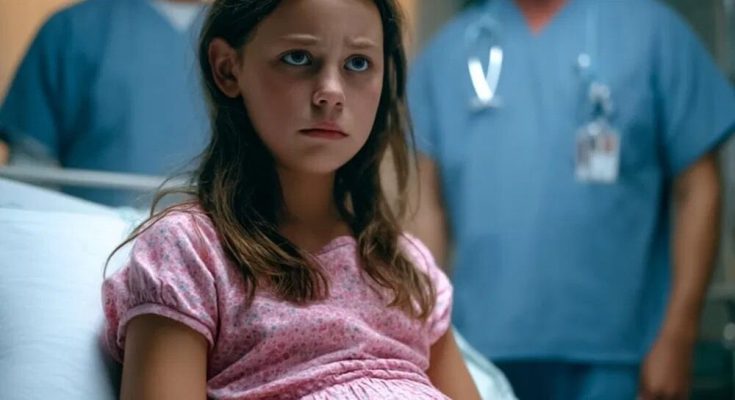
A 12-year-old girl with a large belly was brought to the hospital. When the doctors realized what was inside, they were shocked.
A 12-year-old girl with an unusually large belly was brought to the emergency room. The doctors first assumed digestive problems or even a tumor. But after the ultrasound, a heavy silence fell over the ward. What they saw made them freeze. There was no normal pregnancy inside, no tumor – only a weak spark of life that was about to go out.
Her name was Kira. Quiet, thin, pale, with huge blue eyes and hands that constantly squeezed her stomach. She was admitted to the hospital late in the evening. Her mother was crying, repeating the same thing:
— I thought it was just bloating. Gas… But she screamed in pain at night, curled up into a ball. And now she can’t even get up.
Kira’s father left when she was six. Her mother worked as a cleaner in a shopping center, trying to give her daughter everything she could. They lived poorly, but loved each other. No one guessed what pain the girl was hiding under her smile. She endured it. She didn’t want to upset her mother. She thought it would pass. She drank water, starved herself, just so it wouldn’t get any worse.
When they put her on the bed, Kira couldn’t straighten her legs — the skin on her stomach was stretched like an eardrum. The doctors were in a hurry: tests, IVs, examinations. An ultrasound showed a colossal accumulation of fluid in the abdominal cavity. At first, they suspected internal bleeding. But the blood was clean. The surgeon called an oncologist. The oncologist — a gastroenterologist. The gastroenterologist — an infectious disease specialist…
The diagnosis was rare and terrible: intestinal lymphangiectasia. A disease in which the lymphatic vessels dilate and fluid accumulates in the abdominal cavity. Pain, exhaustion, risk of death – all this could look like just a “bad stomach” for years.
An elderly doctor with kind eyes and gray hair quietly said to the mother:
– Your daughter is holding on by a miracle. Her body has been fighting for months. An urgent puncture, treatment, support are needed. You must be there. She can’t cope without you.
Mom did not leave the ward for a minute. Kira woke up with a damp forehead, opened her eyes with difficulty and whispered:
– Mommy… I don’t want to die… I haven’t finished watching my favorite TV series yet…
The treatment was long and painful. More than three liters of fluid were pumped out of the abdominal cavity. Every movement was painful. Every injection was a test. But Kira didn’t cry. Only once, when her mother brought her a teddy bear with a soft bandage on its belly, tears appeared in her eyes:
— Will he be sick with me too?
After two weeks, it got better. The doctors said that they had never seen such childish courage. The nurse, usually strict and silent, brought her a warm blanket and whispered:
— You’re like an angel. Just don’t go, okay?
Kira’s story quickly spread throughout the entire floor. Other children were told about it:
— Look how Kira is fighting. You can do it too.
She became a symbol of hope for the entire clinic.
But a couple of weeks later, a complication occurred. On Sunday night, her temperature suddenly jumped, and her legs began to swell. The doctors rushed between the machines, another puncture, more tests… Everyone was afraid of one thing — that the body had given up…
At 12, Kira was hospitalized with a swollen stomach. Doctors discovered a rare disease—intestinal lymphangiectasia. Poor and in pain, she stayed strong for her single mother. After painful treatment, she survived.
Bullied at school, she still dreamed of becoming a doctor. Years later, with help from friends and her own determination, she achieved it. She even saved a fellow student from a fire.
Ten years later, Kira treated a girl with the same illness. She told the mother,
“I was like that too. If I survived, she will.”
Kira never sought fame—only to help others. One day, a former patient returned with her daughter:
“I named her Kira.”
This time, Kira cried—from happiness.
